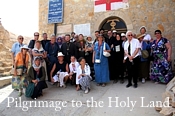A little-publicized group has worked to good effect
by Roy Montgomery, The Vancouver Sun, 14 Aug. 1954
Close by one of the mighty concrete footings of Vancouver’s new Granville Bridge lie the remains of the first Russian Orthodox church on the west coast of Canada. The completion of the building and its opening in 1929 by Archbishop Platon represented the culmination of years of hope and unselfish effort by the members of the first congregation and their priest, Antonin Pokrovsky.
Sad as the sight must be to the remaining members of the early band, as they turn away from the rubble and gaze on their splendid new church, they must admit that progress has been kind, and timely. With the congregation now numbering around 400, the former quarters were stretched to the limit and lack of facilities made social gatherings practically impossible.
The new building at Forty-third Avenue and Quebec was recently completed at a cost of some $70,000. This was made up partly from the compensation derived from the loss of the old church, which had to be removed to make way for the Granville Bridge, and partly from donations of the congregation. It is built in the traditional style of Russian Byzantine architecture, and it brings with it a flavor of the East, strange to most of us here. The style is characterized by the cupolas or onion-shaped domes and the long narrow arched windows, and is similar to many churches in the older towns and cities in Russia.
The long narrow windows, combined with those immediately below the central cupola, make the interior unexpectedly bright. The building was designed by Ross Lort, a Vancouver architect, who, though unfamiliar with the style, was assisted by members of the congregation who supplied him with photographs and other pertinent data.
To Western eyes the first striking feature inside the church is the complete absence of pews or other seating arrangements. It is the custom of the church that the congregation stands, with the exception of the sick and elderly for whom chairs are provided at the sides. Also conspicuous in its apparent absence is the altar. This is separated from the main body of the church by an iconostasis or screen on which are hung icons or holy pictures.
Behind the altar is a large icon depicting Christ’s descent into hell after the Resurrection to save the sinners. The man being raised to his feet is Adam, and the concentric circles represent the spheres of the earth, the center being the medieval idea of hell. This picture is a copy of an icon by the famed icon painter of the 15th century, Dionisius, and is the work of 79-year-old Ann von Kuegelgen of Oliver, B.C. Mrs. Von Kuegelgen, who originally came from Estonia, is a professional artist who studied icon painting in Finland, Poland, Germany and Britain during several flights to escape Communism. An exhibition of her work was held in the Vancouver Art Gallery last Christmas.
In the large Parish Hall, which adjoins the new church, are facilities to cater to the social side of the church life. There is the stage (one of the activities connected with the church is the folk dancing group under the leadership of Mrs. Pashkofsky, which regularly enters folk dancing festivals), and there too are the dining hall and kitchen and space for a future library.
The present congregation consists of people from Russia, the Ukraine, Yugoslavia, and other Eastern European countries. Some of them have lived in Vancouver many years and are engaged in practically every trade and profession. Others have come here more recently from China, having originally fled there from Communism in Russia, only to be forced to flee again.
All of them, the older members of the congregation and the new, have one thing in common. They share a pride in their new church, which was formally dedicated July 11 by His Eminence Leonty, Archbishop of New York, Metropolitan of North America, and three bishops from Toronto, San Francisco and Alaska.

 Russian Version
Russian Version Orthodox Tours
Orthodox Tours Pilgrimage to the Holy Land – 2010
Pilgrimage to the Holy Land – 2010
